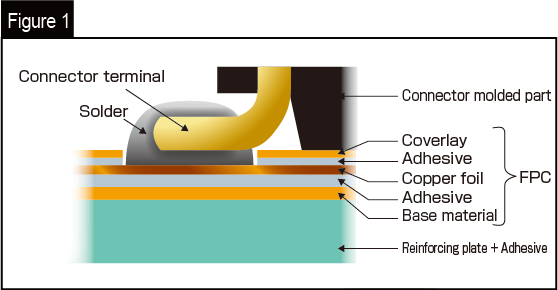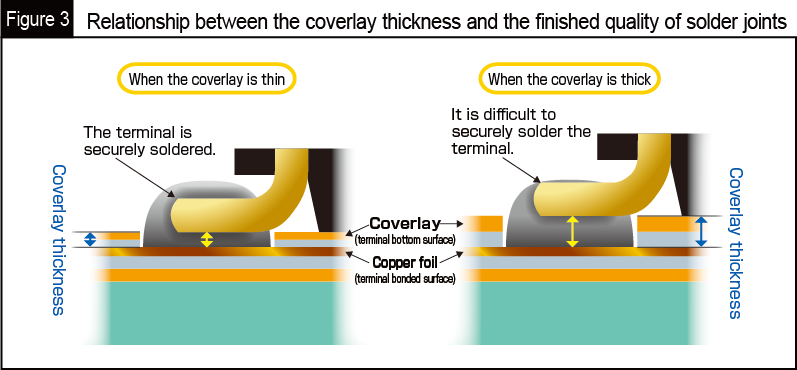This article describes a method to prevent poorly soldered joints by designing the thickness of individual material layers, such as coverlay and adhesives, which make up an FPC.
When performing surface mounted of connectors on FPCs, in addition to adjusting the FPC's footprint and amount of solder, taking the thickness of the FPC's coverlay and adhesive into consideration will allow you to achieve more reliable solder mounting.
As many of you may be aware, FPCs consists of with multiple layers of several different materials.
There is a variety of structures for constructing FPCs, such as one sided FPCs, multilayer FPCs, and those requiring resistant to heat. The typical structure is explained using Figure 1, where the following materials are stacked from the bottom (base material) to the top (coverlay).
- Base material (polyimide, etc.)
- Adhesive to pull the base material and copper foil
- Copper foil used for foot patterns
- Adhesive to pull the copper foil and coverlay
- Coverlay that insulates and protects areas other than those where foot patterns are soldered

In most cases, the surface of FPCs on which connectors are mounted is plated with patterned copper foil, which is protected by an adhesive and coverlay (excluding areas such as for solder mounting where foot patterns need to be exposed). In order to prevent poorly soldered joints, the thickness of such coverlay and adhesive becomes very important.
Some connectors have a standoff (structure for securing a space between the connector bottom and printed circuit board surface), while certain low profile connectors have no such standoff.

A connector without a standoff has terminals even with the bottom of its molded part as shown in Figure 3. Therefore, the thicker the coverlay and adhesive of the FPC, the longer the distance between the bottom of the terminal and the copper foil surface to be joined by soldering. More specifically, as the distance increases, solder is less likely to bond, which may cause poorly soldered joints.
On the other hand, the thicker the coverlay and adhesive of the FPC, the greater the amount of screen printed solder, thereby increasing the risk of excessive solder.

Therefore, for actually mounting connectors on FPCs with solder, the structure of the coverlay and adhesive must be as thin as possible.
If poorly soldered joints are inevitable, then check the thickness of each insulating layer of FPCs by carrying out actual measurements. The general thickness of the coverlay including adhesive is approx. 30 um. However, if the measured results exceed this value, then review the thickness of the FPC's coverlay and adhesive that support the bottom of connectors.
How did you go with the explanations above? This course explained the required FPC coverlay and adhesive thickness for mounting connectors with solder on FPCs. Please keep these explanations in mind when designing FPCs in order to prevent poorly soldered joints.





